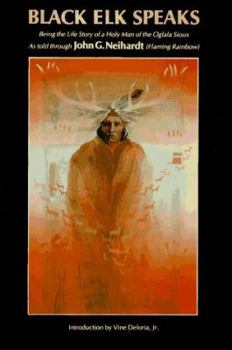Black Elk Speaks: Being the Life Story of a Holy Man of the Oglala Sioux
Select Format
Select Condition 
Book Overview
The most famous Native American book ever written, Black Elk Speaks is the acclaimed story of Lakota visionary and healer Nicholas Black Elk (18631950) and his people during the momentous, twilight years of the nineteenth century. Black Elk grew up in a time when white settlers were invading the Lakotas' homeland, decimating buffalo herds and threatening to extinguish their way of life. Black Elk and other Lakotas fought back, a dogged resistance that resulted in a remarkable victory at the Little Bighorn and an unspeakable tragedy at Wounded Knee. Beautifully told through the celebrated poet and writer John G. Neihardt, Black Elk Speaks offers much more than a life story. Black Elk's profound and arresting religious visions of the unity of humanity and the world around him have transformed his account into a venerated spiritual classic. Whether appreciated as a collaborative autobiography, a history of a Native American nation, or an enduring spiritual testament for all humankind, Black Elk Speaks is unforgettable. This special edition features all three prefaces to Black Elk Speaks that John G. Neihardt wrote at different points in his life, a map of Black Elk's world, a reset text with Lakota words reproduced using the latest orthographic standards, and color paintings by Lakota artist Standing Bear that have not been widely available for decades.
Format:Paperback
Language:English
ISBN:0803283598
ISBN13:9780803283596
Release Date:August 1988
Publisher:University of Nebraska Press
Length:1000 Pages
Weight:0.80 lbs.
Dimensions:8.0" x 0.5" x 5.5"
Related Subjects
13 - 17 Years Americas Biographical Biographies Biographies & History Biography & History Earth-Based Religions Ethnic & National Historical History History & Criticism Movements & Periods Native American Native American Studies Other Religions, Practices & Sacred Texts Politics & Social Sciences Social Science Social Sciences Specific Demographics Tribal & Ethnic WorldCustomer Reviews
3 ratings
Thank you !!
Published by Wesley Earl Loveless , 2 years ago
Thank you, Sincerely, Wesley Earl Loveless, Gloversville, New York 12078 U.S.A. Glove City !
Ghostly Reminders
Published by Thriftbooks.com User , 17 years ago
As I recall, it was one of those hot, smoggy summer days in LA. We were sitting on a park bench in the shade. The park was one of those anonymous lttle collections of half-watered, half-dead grassy spots that dot the LA sprawl. Present were Manuel, his wife Vera chief of what was left of the Huhumonga tribe (Gabrielino, in Spanish), and several of us white activists. We were all working to preserve the remaining sage scrub beds (a sacred plant to Western tribes) from San Bernardino area developers. Now, Manuel, as long as I had known him, was a mild-mannered man, content to let Vera make decisions for those Gabrielinos still active in tribal affairs. Maybe, it was the summer heat or the unruly kids playing nearby, I don't know. But suddenly Manuel jumped from the bench, strode over to the several families with the kids, and in a stern and steady voice proceeded to remind them that all the land upon which they now walked and drove had once belonged to his people who had peaceably roamed the land. A moment later, he returned, and we resumed without comment. But I've never forgotten that moment, not because it was embarrassing for Manuel or for the bewildered families who had no idea who he was, but for what it demonstrated to me. That even in the middle of one of America's great cities, having long ago replaced the vast beds of coastal sage and peaceable people, there remain ghostly encounters with a very real pre-European past. And that's the sort of glimpse Black Elk Speaks provides in wonderful detail. The past comes alive through the proverbial eyes of a revered man whose people have been overly villified or overly romanticized, but rarely portrayed in all their human complexity. Black Elk, I think, manages the complexity as he recounts experiences from boyhood through young adulthood. From the poetically practical names of people and months, eg. Moon of the Grass Appearing (April), to the migrations across traditional lands, to the historic battles with the Wasichus (white men), to the Ogalalas' end at Wounded Knee, the reader is immersed in a strange and vanished culture. It's said in the notes that the Indian Black Elk and the white man John Neihardt possessed something of a common spirit that communicated across racial and linguistic barriers. As it reads, the seamlessly flowing narrative demonstrates something of a communal overlap, a kind of deeper commonality. The book's centerpiece revolves around the nine year-old Black Elk's Great Vision, recounted here in all its colorful and lyrical detail. Whatever the prophetic value, the strength of Black Elk's Vision clearly guided and infused him for the remainder of his life, and provides a powerful potrait of another people's wishes and dreams. Frankly, I've never put much stock in the metaphysics of visions, whether of the white man's Biblical variety or the Native American's pantheistc kind. But I have to confess that when I compare America's great national vision of Manifest Destiny
One of the Best Books I've Read
Published by Thriftbooks.com User , 24 years ago
This is the biography of Black Elk, a wichasha wakon (priest) of the Oglala Sioux, as recorded by John Neihardt. This is not some cheesy new age fiction nor is it a dry documentary told from a western view point. This is the actual life story of a holy man and goes into great detail about his visions. From his words we are able to catch a glimpse of Native American religion and spirituality on the Great Plains as it was in the late 1800s/early 1900s. This stands out as one of the greatest works on Native American religion to date. I highly rocemmend that ANYONE read this book.







